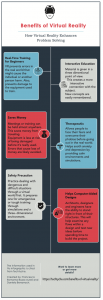The same software that transformed video games is now being used by a NASA official to help build ground support equipment at Kennedy Space Center.
“NASA is using virtual reality to enhance and improve the design cycles,” said Antonio Pego, a NASA aerospace technology engineer.
NASA engineers test human system integration to examine a model before time and money are spent on manufacturing.
“There’s a tremendous amount of cost savings associated with virtual prototyping … powered by a Vicon motion capture system to get people immersed into that world to interact with the product,” said Jeffrey Ovadya, the director of sales and marketing at Vicon, a British-based company that develops motion-capture products and services.
NASA engineers use two different softwares called Vicon and Jack. They apply human simulation and motion capture to test if a certain piece of equipment is within the safety limits for the average human being.
The space center engineers customize equipment based on the fifth and 95th percentiles of people, which is about a 5-foot to 6-foot person.
According to Pablo Sanchez, a NASA communicator on graphic and web design, virtual reality is now “one of the technologies that are advancing the most in today’s society because of the creativity and the abilities” it has.
Once a NASA engineer applies an idea, certain actions need to be taken.

Ovadya mentions that when the engineers start testing the product, they need “physical mockups” of it. This could take numerous trials which “costs a bunch of time and money.”
Thousands of dollars have been spent on trial and error; however, these costs have been reduced since NASA engineers have used virtual reality.
“They can start doing design work in virtual reality … to save a lot of money on labor, mockup, and prototyping costs that would be associated with non-virtual productions,” said Ovadya.
Virtual reality allows engineers to conveniently make changes. They have the ability to foresee an issue and solve it right then and there, rather than having to recreate another physical model.
“We’ve been able to minimize some errors and catch some things prior to manufacturing them and be able to modify operations,” said Pego.
NASA engineers did not just immediately trust this gaming software. They had someone do all the equations ahead of time in order to verify if the software was accurate.
“Maybe there will be a few issues left, but what we’re doing is reducing these issues,” said Pego.
Aside from saving money and time, virtual reality also creates a safer environment for both the engineers and individuals that will use such equipment.
“There are software packages that do kinematic analysis…you can assess whether or not it’s going to impact your astronauts and your engineers and people that are actually taking advantage of the products you are designing,” said Ovadya.
By taking body measurements and inputting the amount of force on the person’s body, the software will alert the engineer if safety limits are exceeded.
“When it [the software] does the calculations…it shows how much force there is on his wrist, on his back…and you can then, by looking at it, say hey this operation isn’t very safe,” said Pego.
NASA engineers can test certain project ideas without having to risk a person’s life. Virtual reality allows the user to work with certain equipment in a virtual world, preparing them ahead of time to use it in the real world.
“This is what humans need to try to do, standardize things and make them more intuitive and understand it so there are less mistakes,” said Pego.
Due to such advancement, Pego plans to make virtual reality a protocol when ideas are proposed.
“What I’m trying to do is push it [virtual reality] to get it implemented in the design cycle,” he said. “Rather than spending money fixing something that should’ve been caught ahead of time … we can use that money training another astronaut or building another satellite.”
Footage of a motion capture system used by Antonio Pego to help test NASA equipment.

































